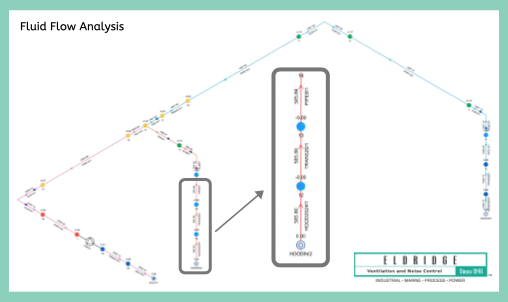The design and equipment selection of a simple general building ventilation system design can be done with a high degree of accuracy using spreadsheet calculations. However, for more critical air flow systems, such as a wind tunnel, electric motor cooling system or a multi-unit diesel motor room, the level of precision required to get the air flow right requires a Fluid Flow Analysis (FFA). In this article on Modeling Critical Air Flow Systems, I will discuss what differentiates an FFA performed by Eldridge from others in the market.
FFA Inputs
When performing an FFA, the old rule of “garbage in equals garbage out” applies. A critical air system FFA is flawed from the start if its geometry is not properly quantified. The first step in the quantification process is to identify every element in the system that impacts air flow such as bends, transitions, entrances and exits. The second and more difficult step is determining the pressure drop parameters associated with each element in the system. Eldridge’s vast experience with critical air flow systems allows us to calculate the correct pressure drop parameter to match the geometry of each element from an extensive database of pressure drop data.

Dynamic Modeling
Most critical air flow systems will have more than one fan. The performance of each fan in the system will impact the performance of the others. Quantifying the performance impact of each fan on the others based on the geometry of the system is difficult. This presents a challenge when using typical CFD software because it only allows input of one performance point for the entire system. However, we know that multiple fans in a system will work with and against each other and simultaneously calculating flow from each fan is not possible without dynamic tools.
To facilitate the complexity of these calculations, Eldridge has developed proprietary FFA software that solves this problem. We can input the entire performance profile of a single or multiple fans and let the dynamic modeling within the software select the exact performance of each fan to balance the air flow in the system. If we see that our initial fan selections don’t provide an adequate quantity of air flow, then we can input the performance profiles for different fans until we have a balanced air flow at the exact quantity.
Conclusion
When Eldridge guarantees the performance of a critical air flow system that we have designed, we don’t just do it with words! We can show you the proof! If you have doubts about the performance of your critical air flow system design, call us. One of our team will help you understand how modeling critical air flow systems can achieve optimal performance.
